The best 360-degree camera
You have several good options from Insta360, Ricoh and Garmin.

By Geoffrey Morrison
This post was done in partnership with Wirecutter. When readers choose to buy Wirecutter's independently chosen editorial picks, Wirecutter and Engadget may earn affiliate commission. Read the full 3060-degree camera guide here.
After 70-plus hours of researching over nearly three years, including days of hands-on testing for this update and two months using our main pick, we've found that the Insta360 One X is the best 360 camera. It produces attractive, high-resolution, 360-degree, fully spherical images and videos that you can scroll around to show a view of every direction surrounding the camera, plus unique non-360 "FreeCapture" 1080p videos that show just the most interesting sections of your 360 content. The camera is small and easy to use and has excellent apps for your phone and computer.
The Insta360 One X is the camera that does everything well. The specs on the One X read like a 360 camera wishlist: 5.7K resolution (the highest you can get in this price range), removable battery, on-camera display, Bluetooth, Wi-Fi, an app with advanced editing methods, and more. It's as if Insta360 looked at everything people wanted in a 360 camera, and stuffed it all into the One X. Even better, it performs as well as you'd hope looking at the features list. The camera isn't waterproof, but two waterproof cases are available, along with numerous other accessories.
Though it lacks some of the advanced features of the Insta360 One X like robust image stabilization, a removable battery, and 5.7K video, the Ricoh Theta V is a solid alternative if our main pick is sold out. The Theta V's simple design belies the complexity within, offering high-quality images and videos that look more natural and immersive than those taken by most other cameras. Though its resolution isn't as high as that of some others, the quality of its lenses and image sensors let it take excellent photos and videos.
If you're looking for something you can take surfing, swimming, mountain biking, or otherwise action cam-y, the Garmin Virb 360 is waterproof to 33 feet (10 meters), records 5.7K video, and has a number of cool editing features. It's significantly more expensive than our other picks, but offers a lot more for people looking for a 360 action cam. While the similar GoPro Fusion has a bit better image quality, it is significantly more difficult to use and live with. So for most people, the Garmin is the better option.
Why you should trust me
In addition to being the editor-at-large for Wirecutter, I also review 360 cameras for Forbes. I was an early adopter of the format and have used several cameras in my other, other life as a travel writer and photographer for Forbes and CNET. You can check out samples from different 360 cameras I've used and reviewed on my Flickr page and on my YouTube channel. I also post lots of Tiny Planet photos, shot with 360 cameras, on my Instagram.
Why get a 360 camera?
Although it's unlikely that a 360 camera will replace a traditional camera, it offers additional creative options for fun and interesting photos and videos. Whether you're getting into virtual reality or you're a real-estate broker hoping to show off a home in a new way, photos and videos captured with a 360 camera offer a more immersive way to see places than any other media. Viewers can enjoy a full sphere, allowing them to take in, for better or worse, everything in a space—not just a narrow view from the Eiffel Tower, but the sweep of Paris, you, and the tower itself. Not just a selfie with the crazy lights of Shinjuku, Tokyo, but of the entire street and everyone around you. Taking a good 360 photo or video is challenging, needing great placement and environment, but the result can be fantastic.
In addition, most 360 cameras now let you create a standard, rectangular 1080p video using just the most interesting portions of your 360 sphere. Think of this like cutting out a section of the sphere, your face for example, and just showing that instead of everything around the camera. In most cases this video is highly stabilized, and looks professionally smooth. It can also have pans, zooms, and time lapses that are far more interesting and creative than what a traditional camera can easily create. On the photo side, Tiny Planet photos offer a unique look at an environment. These types of photos and videos are viewable on any social media platform. We have some video clips below that demonstrate this.

The 360 photos and videos themselves, however, aren't viewable everywhere. Facebook and Flickr are two of the biggest free websites that can correctly display the images. YouTube, Vimeo, and Facebook are three of the biggest that can correctly display the videos. Most recent mobile phones can show 360 media and some use their internal sensors to act as a sort of moving window into your photos/videos: Load the image, then move the phone to see the image as if you're inside it. It's pretty amazing the first time you see it work.
Although it's unlikely that a 360 camera will replace a traditional camera, it offers additional creative options for fun and interesting photos and videos.
Lastly, the photos and videos you will get from any consumer 360 camera are not going to be anything close to the quality you're used to. Even the best results will be softer than a normal HD or 4K video, because the same number of pixels now have to show the entire photosphere. Still, our picks produce some great images. Because of the smaller image sensors in these cameras, the images are typically noisier, especially in low light, than those from point-and-shoot cameras or modern high-end cell phones.
You don't need a VR headset to enjoy 360 content, though having one adds a layer of realism.
How we picked
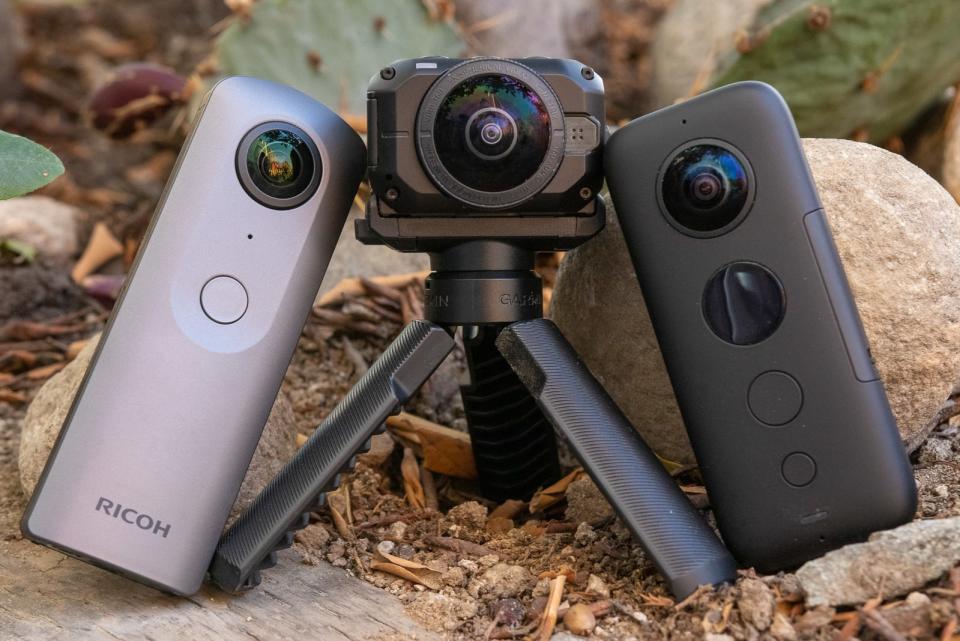
There aren't that many 360 cameras available, and only a few new models have come out since our update in summer 2018. With these new models, though, we added a few "must-have" features to our list.
At least 4K video capture: Because you're seeing only a portion of the video at any one time, resolution becomes an issue. While traditional 1080p video can look sharp, 1080p 360 videos look very soft. Even 4K, which offers four times the resolution of 1080p, is still not enough with 360. It's the minimum we recommend. To put it another way, imagine taking a picture with just what your eyes can see right now, without moving them or your head. That "image" in 4K would look very detailed. But now imagine using the same number of pixels to "photograph" everything you can see while moving your head. It wouldn't be possible to have the same level of detail with the larger field of view. So with 360, the more resolution the better. In 2018 several models offer greater-than-4K resolution. Though not a requirement yet, it will be going forward.
The ability to capture and share a full 360 sphere: There are many cameras available that don't offer photo spheres as much as photo "domes." In images made with these cameras, there's a large area around the bottom of the camera that's just black. Think "bowl" versus "globe." There are now many excellent cameras that create the full 360-by-360-degree photo/video spheres/globes, so we decided to limit our picks to those. These images and videos are more immersive and offer more of a wow factor. To create such media, these cameras generally have two lenses and image sensors.
Compatibility with your phone: Some 360 cameras unlock their full potential only with a specific OS, or even a specific phone maker. While these can be good values for people with the right phone, they can't be the best for most people. Though no camera will work with every phone, we at least wanted similar levels of iOS and Android compatibility.
Waterproofing (for action-oriented cameras): There are several great action 360 cameras at or above $500. At that price, they had better be able to stand up to some real action.
Size and design: These cameras don't have to be tiny, but you'll be more likely to carry around a small camera with a simple, intuitive design that's easy to hold than some large monstrosity.
We didn't look at commercial or professional 360 cameras, which cost thousands of dollars. These cameras use far more than just two sensors to capture the image. Their performance is likely fantastic, but we figured these would be far beyond what most people would want to spend for something that is, at best, a secondary camera.
This left us with a handful of new models to test: Insta360 One X, Xiaomi Mi Sphere, Acer Holo360, and the Vuze XR.
Several great models from 2017 have carried over, and we also compared against those, like the Rylo, and our former top pick, the Ricoh Theta V.
How we tested
We gathered together the Theta V, One X, and Mi Sphere. The Garmin Virb 360, being much more expensive and waterproof, is in a separate category that we'll call action 360 cameras, of which the Nikon KeyMission 360 and GoPro Fusion are similar. We'll cover those when we talk about our upgrade pick.
Having used these cameras extensively, but individually, already, I took multiple photos and videos with the three main contenders together. You can see examples of their photos and videos below and on my aforementioned Flickr page and YouTube channel.
There is a lot to consider when it comes to the image and video quality of 360 cameras. First, all of the normal camera aspects: color, dynamic range, noise, detail, and so on. Additionally, and unique to 360 cameras, you have what's called "stitching." All of the 360 cameras we tested have two image sensors, essentially back to back. It's sort of like if both the front- and back-facing cameras on your phone took an image at the same time. How well those images are stitched together by the camera dictates how seamless the final photosphere is.
All of our picks do a pretty good job with stitching, but they also all have a "dead zone." There is a sphere around the camera that isn't in the photo. The cameras essentially remove themselves from each image, but they also take a bit extra with them. As you'll see in the samples above, if you're holding the camera or something is too close, the camera might cut it off a bit. Generally, this isn't an issue, but the farther apart each sensor is, the bigger this dead zone is. Most, though not all, companies have figured this out by now and place the sensors very close together.
In addition to the basic picture quality, I also paid close attention to how well each camera connected to phones, how well their apps worked, and how easy it was to upload media to the Web.
Our pick: Insta360 One X
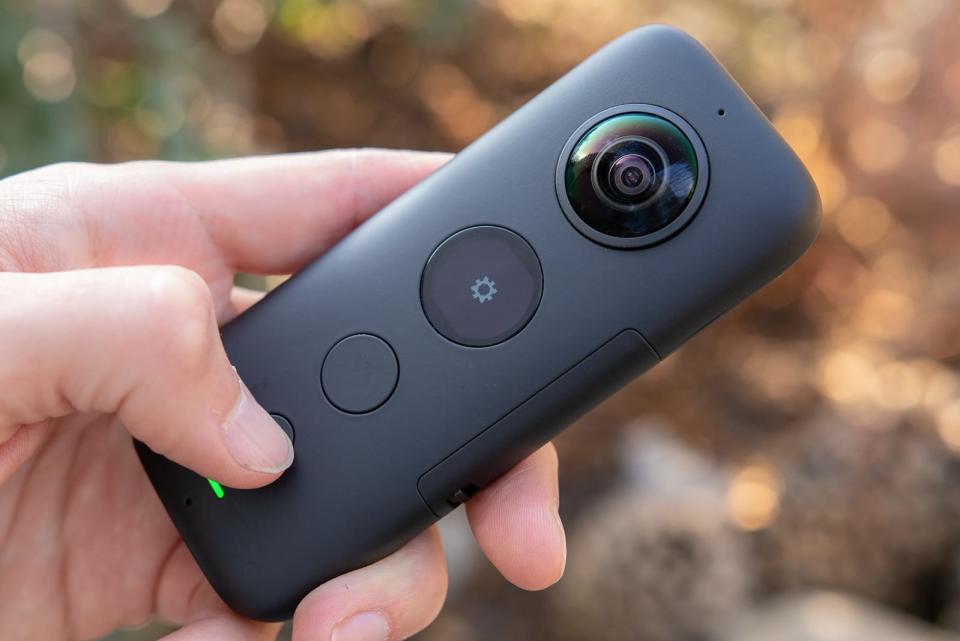
The Insta360 One X is pretty much everything we're looking for in a 360 camera: excellent image quality and a thoughtful physical design, with an app that lets you create clever and fun photos and videos of both 360 and traditional 1080p varieties. It takes everything we liked about our previous runner-up pick, the Insta360 One, but adds in better image sensors, lenses, a removable battery, and a camera body with a small screen so you don't have to pull out your phone to adjust settings.
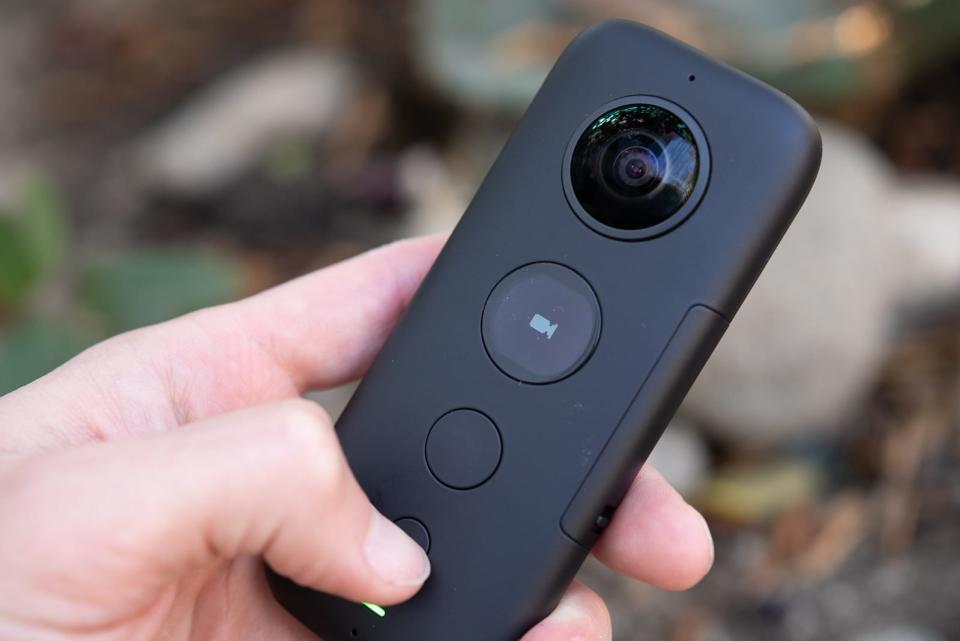
Physically the One X is on the small side for a 360 camera, which is a good start. The thin frame keeps distance between the image sensors at a minimum, which is crucial for good stitching of the two hemispherical images to create a 360 sphere photo or video. A small screen on the back lets you adjust settings and modes without having to connect to your phone. It has a removable battery, an excellent feature that's surprisingly rare among 360 cameras. On the bottom is a ¼-screw thread to connect to a selfie stick or tripod. A single SD card saves your content. It has both Bluetooth and Wi-Fi, but included short cables let you connect directly to any phone or tablet that has a Micro USB, Lightning, or USB-C connection, allowing for significantly faster transfers than what's possible with wireless.
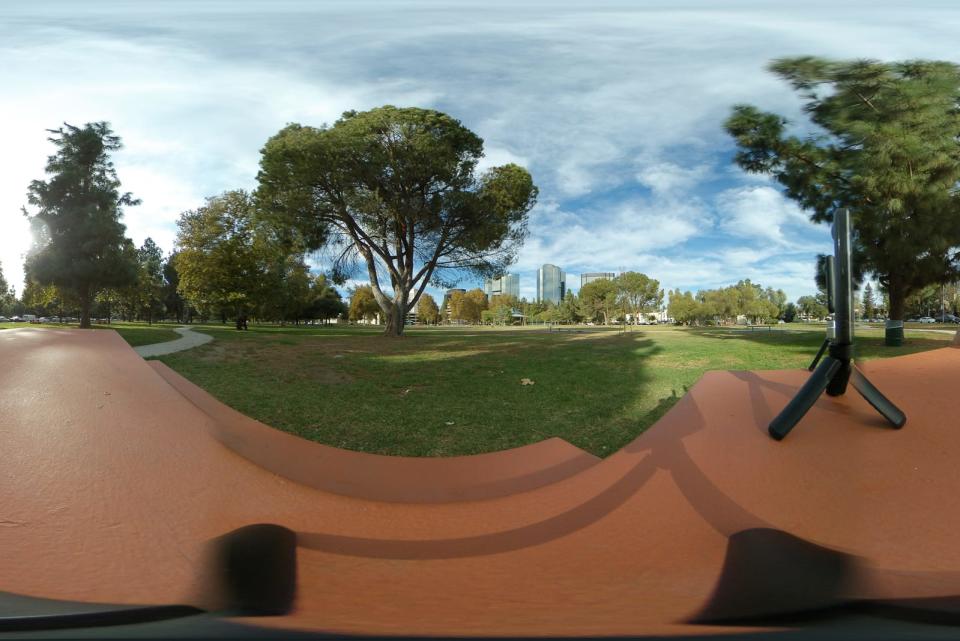
Inside are two Sony CMOS 1/2.3" sensors. These, paired with f2.0 aperture 200-degree lenses output photos at 6080×3040. This is lower than some competitors, but the images are sharp, with good contrast. A high dynamic range video mode lets you expand the apparent contrast if the situation warrants it.
Video, on the other hand, is among the highest resolution and frame rate of any consumer 360 camera. At 30 frames per second, the One X can create a 5760×2880 or "5.7K" image. Only the Rylo is higher, at 5.8K, but at a lower 24 fps frame rate. In use, the video tends to look similar in quality to the GoPro Fusion, which is widely considered to have the best 360 video (though it has other issues, which we discuss in the Competition section below).
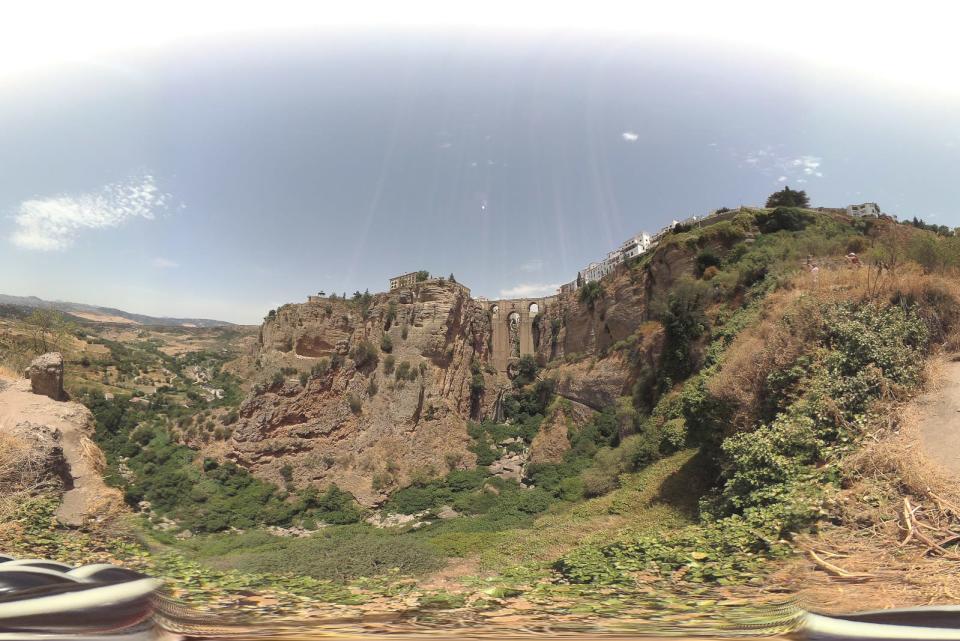
Perhaps more interesting is that the One X can record 4K video at 50 fps, and 3K at 100 fps. This lets you create professional-looking and supersmooth slow-motion videos. Like its predecessor, the One X has Insta360's FlowState image stabilization, which is among the best in the 360 camera world. An HDR video mode has now rolled out to iOS and Android, but wasn't available during our testing.
Insta360 has been known as an app in search of good hardware. The cameras were fine, but software was really what the company did best. Regular—and huge—updates added numerous excellent features. If another 360 camera has a cool feature, it was a safe bet that Insta360 either had it, or would add it shortly. That continues with the One X. With photos you can create Tiny Planets of course, but also short videos Insta360 calls Spin View that add motion to the image, swooping and zooming in different ways. Some of these are in the video below and at my Flickr page.
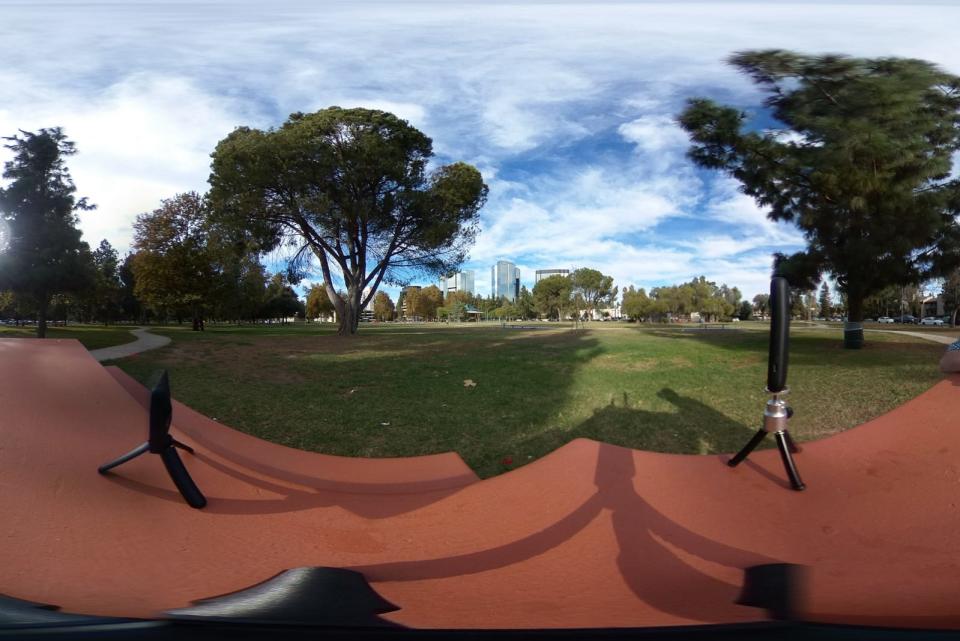
With videos, the editing options are even more extensive. You can create a rectangular 1080p video using just the most interesting portions of your 360 sphere. Imagine standing inside the sphere of your video, and using your phone as the "viewfinder" to focus just on the best parts of what you shot. Perhaps your face, or what you were looking at, or a pan from your face to what you were looking at, and so on. Insta360 calls this FreeCapture, and it's similar to what Rylo, GoPro, and Garmin have as well. It works easily and intuitively. If you record at one of the camera's higher frame rates, you can add slow motion to the videos with ease. You can also speed up the footage for a hyperlapse-style fast-motion video.
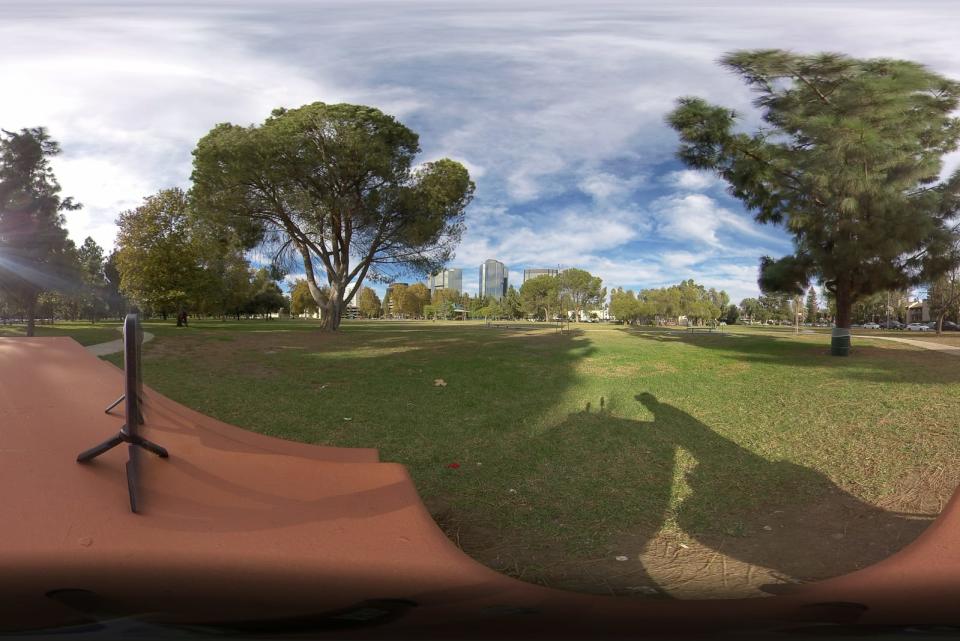
This all lets you create photos and videos far beyond the simple spheres the 360 camera category was once known for. While these features are available in other cameras, no other camera combines them as well, with such excellent hardware.
Insta360 released an impressive number of accessories with the One X. We tested only the selfie stick, but it was solidly built and disappeared from images and videos. The company also released a superlong selfie-stick extender, a handle to help create a Matrix-like bullet-time effect (thanks to the camera's slow-motion ability). The two waterproof cases, one for surf and one for scuba, have modes in the app to stitch underwater content correctly (always an issue). It even has a "lawn dart" called the Drifter that lets you throw the One X and have it land without harming the camera (theoretically). A GPS-enabled remote lets you add telemetry data as an overlay to videos, like what the Garmin Virb 360 can do. Which is to say, whatever you want to do with your One X, the camera probably has an option for it.
Flaws but not dealbreakers
Like all 360 cameras, the biggest issue with the One X right now is with the software. We've seen lots of reports of bugs and app crashes from owners, and it routinely refused to connect to my Pixel 2 during testing. Or should I say, the camera connected to my phone, but the app refused to acknowledge this fact. Insta360 has already rolled out a number of updates fixing this and many of the launch issues, and it likely will have done so several more times by the time you read this, but no 360 camera is as smooth an experience as most other modern tech products. Occasionally it's going to annoy you.
Another issue is the overall muted colors. As you can see in the videos above, and to a lesser extent the photos, other 360 cameras create a far more vibrant image. This is largely adjustable via post-processing in apps like Snapseed, Photoshop, or Premiere, but out of the camera, they're a bit bland. This is something Insta360 can, and likely will, fix with an update, but for the time being if you're hoping for some true Instagram-worthy image quality, you'll need to tweak it a bit first.
With just a single microphone, audio quality is a bit thin and not as clear or as immersive as the Theta V's multiple mics. It's not a dealbreaker, but if you're recording something where audio is important, consider using a separate mic and recorder. I recorded the same video with me talking about both cameras, so you can compare the two. You can check out the One X here and the Theta V here.
Low-light video performance could be better, though that's true of all 360 cameras. You can get a taste of what that looks like in this video.
As with all 360 cameras, not every phone/tablet is going to have the horsepower to be able to stitch and export photos and videos. Insta360 has a list of compatible devices, though keep in mind this is just a list of what will definitely work. If your device isn't here, it might still work, but perhaps slowly or only partially. But really, if you don't have a recent, higher-end phone, you shouldn't expect any 360 camera to work flawlessly. Triggering the shutter, starting the record, or outputting photos will likely work on a lot of devices, but 4K videos, not so much. That's not specifically an Insta360 issue, but it is worth mentioning.
Last, whatever camera you buy, consider getting a case for it. All of these cameras have lenses that stick far out from the body. They scratch easily, and because of their small size, even minute scratches are noticeable in the images. The Ricoh and Insta360 come with neoprene sleeves, which work pretty well if you're careful not to crush them at the bottom of a bag.
Runner-up: Ricoh Theta V
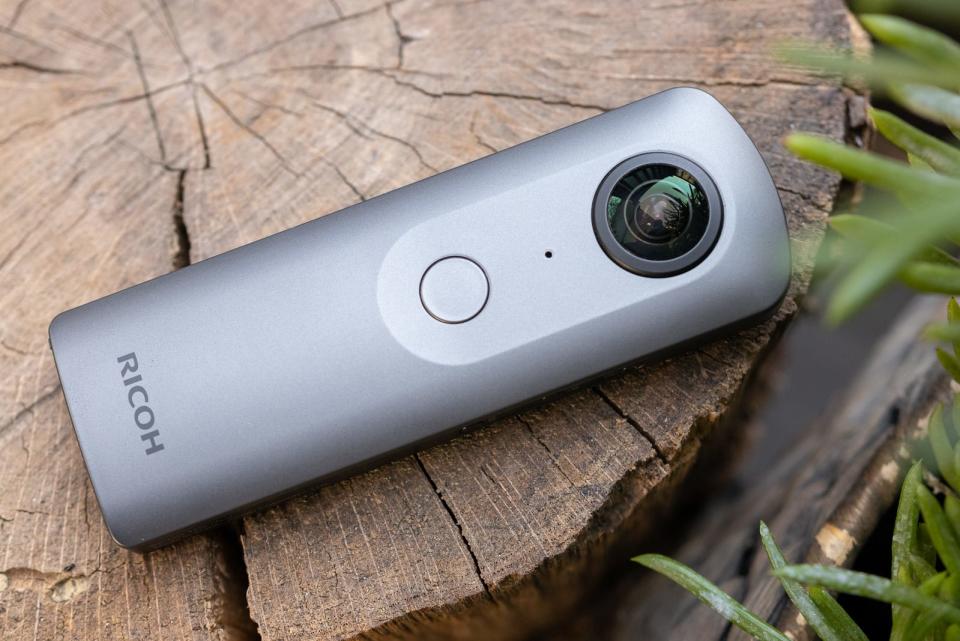
If the One X is not available, or you have very high standards for audio recording for your videos, consider the Ricoh Theta V. It doesn't have some of the features found in its competitors, like robust image stabilization or the highest-resolution video, but overall it works and works well. Its ease of use, support across all mobile platforms, and excellent overall performance make it a well-rounded and highly capable 360 camera.
The narrow shape and small lenses end up being quite convenient, making it easy to hold and use, while taking up little space in a bag. It's slightly taller than the One X, but both are still quite small.
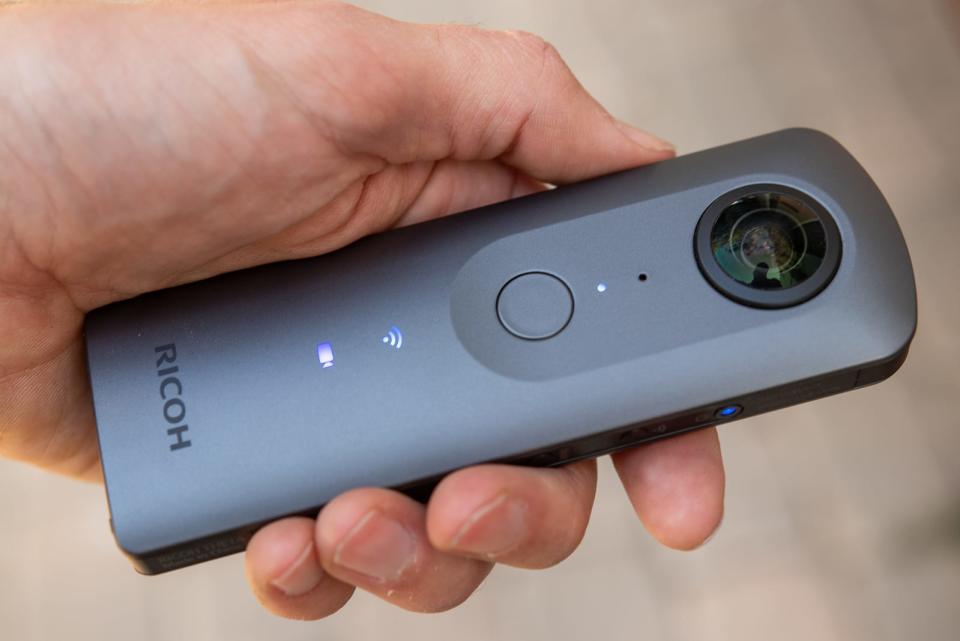
The V has no screen at all, just illuminated icons to show mode and Wi-Fi status. It's really just about turning it on and pressing the shutter button. This simplicity works, but requires you to connect your phone to adjust any settings.
Photo quality is better than its relatively low resolution would imply. Great dynamic range and vibrant color put it well above most of its competitors. It also does a great job stitching the two hemispheres into a single sphere, something Ricoh is still one of the best at (for consumer-level cameras anyway).
The Theta V's 4K video is still good, but now lags behind competitors like the Insta360 One X. The lenses and sensors are of high quality, so the result still looks good, though lacking the detail of the cameras with higher resolutions. At 30 frames per second it's fine for normal video, but the One X can do 4K at 50 fps, letting you create some gorgeous slow-motion effects.
If you aren't satisfied with the audio that the One X records on its single microphone, the Theta V's multiple mics may be a reason to opt for it instead if you don't already plan to record audio separately.
The Theta V doesn't offer the USB-to-phone transfer of the One X, but does have fast dual-band Wi-Fi. This greatly boosts transfer speeds of photos and videos; 4K videos still take a while, though, due to the large file sizes. Alternatively, you can hook it up to your computer via USB.
The Theta software, available for Android and iOS, has most of the editing features that the One X does, just split across two apps. The main app has the right amount of adjustments, including exposure, shutter speed, and ISO. It has a built-in HDR photo mode as well. The app occasionally crashes, but software issues are sadly par for the course with 360 cameras; although I never found it got in the way of using the camera. Then there's the Theta+ app that lets you create Tiny Planet photos and short videos from your images, or edit and add music to videos. It doesn't have the FreeCapture/OverCapture abilities of the One X, however.
To see more of the Theta V's images, check out this Flickr gallery. This one has images from all of the 360 cameras tested. This YouTube playlist has Theta V videos, while this one adds in the other cameras, too.
Although the Theta V does have some stabilization, it's not nearly as effective as the One X's.
In the broadest terms, the Theta V is a solid camera that produces excellent 360 photos and videos, but lacks the additional bells and whistles of the One X. If you're only interested in still photos, check out the cheaper Xiaomi Mi Sphere mentioned in the Competition section below.
Upgrade pick: Garmin Virb 360
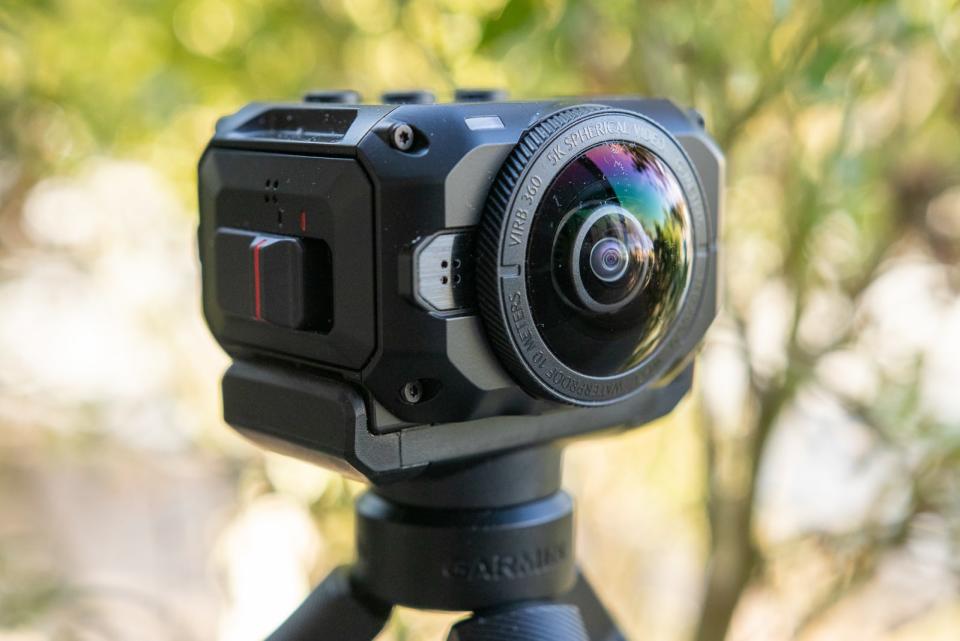
If you need a 360 action cam to take surfing, mounting biking, or in situations where you'd normally use a GoPro, the Garmin Virb 360 offers great picture quality, compact size, lots of features, and image stabilization. Although our main pick can do many of the same action-cam-type tricks, they require additional accessories. The Garmin packs all of that in, out of the box. The trade-off is that the overall image quality isn't quite what you can get from other options.
The Virb 360 is waterproof to 33 feet (10 meters) without a casing, shoots 5.7K video, and has digital video stabilization. Photos are lower-resolution than our other main picks', at 5640×2816.

For an idea how normal images and videos look on the Virb, check out this YouTube playlist or this Flickr album.
Because of the distance between the sensors, the Virb has a larger "dead zone" than the Insta360 One X. So you might experience slight stitching issues in a wider sphere around the camera. Where the One X's dead zone is roughly a sphere no larger than the diameter of the camera's length, the Garmin's is larger even though the camera itself is smaller. Not a dealbreaker, but it's something to consider. Overall stitching is pretty good. It also underexposes images slightly, so they're a bit dark, but with in-app settings and/or a little image post-processing, this is easily overcome.
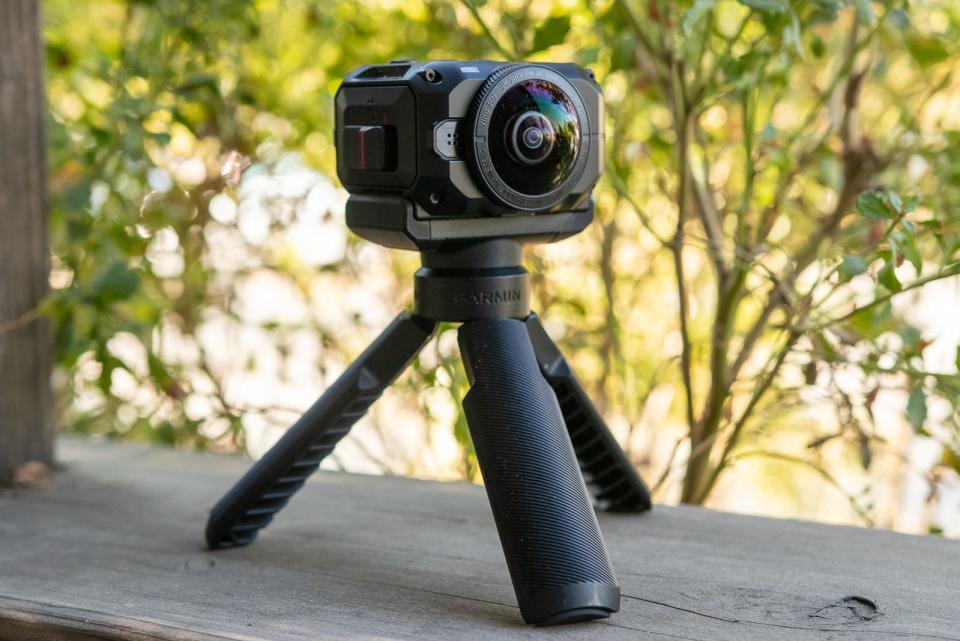
The app has manual picture settings and offers a HyperFrame Director Mode that lets you create a 2D 1080p video with a virtual camera within your already-shot 360 video. The GoPro Fusion, Rylo, and Insta360 have a similar feature.
The main 360 action-cam competitor to the Virb is the GoPro Fusion. We discuss that camera in more detail in the Competition section below. The short version is that though the Fusion can produce some gorgeous video—better than what's possible with the Virb—it is so frustrating to use that we can't recommend it.
If you're trying to decide between the Virb and the One X, we'd say that if you plan to only occasionally use it as an action cam, the One X is better. If you're going to use it only as an action cam, the Virb is the better choice.
How to edit and share 360 videos and images
Not every website can display 360 images as 360 images. In fact, as you can see above, most can't. The main free websites to share on are Facebook, Flickr, Vimeo, and YouTube. There are others as well, though they aren't as popular. Many of the early bugs with 360 photos, like the websites not understanding the image is a 360, have largely been fixed.
Adobe has added 360 photo editing to Photoshop. This is fantastic, as you're now able to add or remove logos, hide random strangers, and otherwise spot edit just like you would with a regular photo. For example, you can now remove a 360 camera's tripod in just a few seconds. If you just want to adjust color, contrast, brightness, and so on, most photo-editing software can do this and keep the metadata intact so Facebook and the like can read that it's a 360 image. If you edit a photo and then it appears on Facebook as a standard image, your editing software might be to blame.
All of the above cameras come with smartphone video apps, and most come with desktop versions as well. These vary in quality—some allow for editing, others just stitching and conversion. Many third-party video-editing programs, like Adobe Premiere, will edit 360 videos as well. Just keep in mind that 4K and 5.xK videos take up a lot of storage space.
For a more in-depth look at how to use 360 cameras, check out my Beginner's Guide To 360 Cameras over at Forbes.
The competition
Ricoh's Theta Z1, announced in early 2019, has two 1.0-inch back illuminated CMOS image sensors. These are significantly larger than the sensors in other consumer 360-cameras. In theory, these will produce images with greater dynamic range, and lower noise in low light situations, than other 360 cameras. Still images have a respectable 6720x3360 resolution, but video resolution is only 4K at 30fps. At around $1,000, it is likely beyond the scope of this guide. We'll keep an eye on it in though, in case it turns out to have a significant leap in performance to justify its much higher price.
Insta360 also announced a new 360 camera in early 2019, though it doesn't replace our top pick. Called the Evo, it is a bit different in use and design, looking more like two GoPro cameras mounted back-to-back. In addition to being able to take 360 photos, the two halves are connected via a hinge. Pivot them out so the lenses are side-by-side and the Evo can take 180-degree 3D photos and videos. Resolution and framerates are the same as the One X, with 6080x3040 photos and up to 5.7K video at 30fps. The Evo will be slightly more expensive than the One X, at about $420. It won't be a pick for now as we don't think the 3D aspect is necessary for most people. However, if 3D is something you're interested in, the Evo should otherwise perform similar to the One X. It's also worth checking out the Vuze XR, which does a similar 360/180 3D trick, and is mentioned in the comments.
We liked the 360fly 4K last round, and still do, but as a single-lens camera it can't do a full photo sphere (there's a blank area below the camera). We think better options are available now that offer similar performance and a full 360-by-360-degree image/video.
The 360fly HD shares many of the same features (and limitations) of the 360fly 4K camera but with a lower-resolution sensor, a single microphone, and 16 GB of internal storage.
The Giroptic 360cam uses three lenses to capture the scene, although it still omits a lower section where the lenses can't get around the camera's base. It started as a Kickstarter project that was set back by manufacturing troubles; some backers waited for their cameras for more than two years after the campaign concluded, and many others required warranty replacements.
We had high hopes for the GoPro Fusion. It's a great piece of hardware that goes head-to-head with the Garmin Virb 360. However, buggy software, limited mobile compatibility, and exceptionally slow and buggy desktop software mean that this camera still isn't quite ready for prime time. It produces probably the best video quality of any 360 camera, but it is so frustrating to use that we can't recommend it for most people.
The Ion360 U works similarly to the Insta360 products, in that it works using your phone as the "brains." In this case, only six phones are compatible: Samsung S8/S8+ and iPhone 7, 7 Plus, 8, and 8 Plus. The Ion360 actually has two parts. There's the camera itself, which is removable, and a case for your phone with an integral 1,260 mAh battery. It makes the phone a bit bulkier, but not outrageously so. Once you install the app, the Ion360 works smoothly. Videos are a bit washed-out, but otherwise seem fine. Photos are likewise "fine." At $300, though, it's a bit expensive, lacking the features of the Insta360 One (stabilization, notably) and the remote usage of the Theta V. If you like the idea of combining an external phone battery, hard case, and 360 camera, the Ion360 U does let you put together all three rather seamlessly.
The Insta360 One was a former pick. It's a good camera, but the One X surpasses it in every way. It's worth spending a bit more on the One X.
The Insta360 Nano and Nano S are more compact and affordable than our main pick, and connect to an iPhone's Lightning port. You can capture shots and videos manually without the phone by pressing its single button, but with no built-in wireless networking in this model, you need to connect it to the iPhone to view or access the images. The Insta360 Air is a similarly equipped camera that connects to a limited selection of Android devices. These cameras are fine for what they are and for their price but are limited compared with what a "real" 360 camera can offer.
The KanDao QooCam is an interesting 360 camera that can also take 3D 180-degree photos. Reviews have been mixed. If you want to take 3D photos, though, it's worth checking out. Also consider the Vuze XR, mentioned below.
The Kodak Pixpro SP360 4K and Pixpro SP360 limit the image to a 235-degree vertical field of view due to a single-lens design, just in 4K and 1080p respectively. To get the full 360, the Dual Pro Pack pairs two of the cameras using a bracket that holds them back-to-back, but this nearly doubles the price, putting it well above that of the easier-to-use competition. Plus, once you've captured that two-headed footage, you need to use software on a Mac or PC to stitch it together.
The Rylo is a great camera produced by a team that worked at Instagram and Apple. They recently updated the camera, via a firmware update, to record 5.8K video. The app is slick, and features many of the same cool editing features we like in the Insta360 One X. The Rylo has the best image stabilization of any 360 camera and the camera is tiny and feels exceptionally well-made.
However, at its current price of $500 it's way more expensive than other options that offer similar features. Also, as of this writing, you can output 360 videos at 5.8K only if you have a Mac computer; no PC software and no mobile app can output that resolution in 360 (no camera's app can, to be fair). The image quality and stabilization are so good that this trade-off might be worthwhile for some. If its price were $400 this would be a worthy alternate to our main picks.
VSN Mobile's V.360º camera looks like a handheld coffee grinder, with a single embedded lens surrounded by a clear plastic chamber that we worry is a magnet for scratches. This camera is waterproof down to 1 meter for 30 minutes (IP67), but its 60-degree vertical viewing angle makes it more of a grand panorama than a 360-degree immersive experience.
The Vuze and Vuze+ are a slightly different product compared with our main picks, in that they create a 3D 360 video. For VR headsets this is especially cool, and if that's what you're looking to do, check them out. However, they're big and expensive, and not quite the same category as our main picks.
The Xiaomi Mi Sphere is an excellent camera and could easily be considered as the runner-up to the runner-up. Its photo quality is a bit better than that of the Theta V, but the Mi Sphere's video quality is a little worse. The app works well enough, has some of the features we like in the Insta360 app, and overall is very easy to use. I brought it with me during my travels this past summer and got many great Tiny Planet photos. If $400 for a 360 camera is too steep for you, this one performs better than its current $300 price would imply. If its price drops below that—which it has before—it's a bargain. The Madv Madventure 360 is the same camera in a different color and with a selfie stick.
The Yi 360 VR is an interesting camera, with 5.7K video resolution, stabilization, and more. However, reviews have come away fairly mixed. The 360 Guy liked the video quality and value for the money, but found photos to be just okay and the stabilization to be fairly poor. Ben at Life in 360, on the other hand, basically couldn't get it to work, finding the mobile app mediocre and Mac compatibility nonexistent. If Yi upgrades the firmware and software, we'll take another look, but for now there are better options.
We also tested the Acer Holo360, Kodak PixPro Orbit360 4K, LG 360 Cam, Nikon KeyMission 360, Ricoh Theta S, Ricoh Theta SC, Samsung Gear 360, and Vuze XR, but these cameras either had bad apps, lack features we deem necessary (such as a tripod mount), were otherwise awkward to use, or had image quality that couldn't measure up to that of our picks.
This guide may have been updated by Wirecutter. To see the current recommendation, please go here.
When readers choose to buy Wirecutter's independently chosen editorial picks, Wirecutter and Engadget may earn affiliate commissions.
